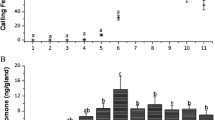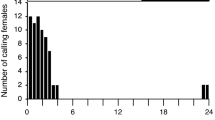Abstract
The hourly and daily variation of calling behavior and sex pheromone production by the female black cutworm moth, Agrotis ypsilon (Rottemberg), were investigated. Both calling behavior and titers of five sex pheromone components showed distinct diel rhythms, and peak periods of calling and pheromone titer were synchronous. Females began to call on the first night after eclosion and called mainly during the second half of the scotophase. The percentage of females calling increased in 1 to 3-d-old females and decreased in 3 to 7-d-old females. Females advanced their calling time with increasing age (1 to 7 d). GC-MS analysis of hexane extracts of pheromone glands revealed that the titers of the five sex pheromone components were very low on the first night after eclosion, but increased sharply and peaked on the third night. Titers decreased greatly with increasing age (3 to 7 d), but from the onset of the scotophase to 4.5 h into scotophase, titers remained invariate. However, from 4.5 to 7 h, pheromone titers, especially that of the primary component Z7-12:Ac, increased sharply and peaked. After the peak, the titers decreased greatly at 8 h, and thereafter decreased gradually to the level before 4.5 h. The quantity of each component almost reached zero after lights-on.


Similar content being viewed by others
References
Baker TC, Cardé RT (1979) Endogenous and exogenous factors affecting periodicities of female calling and male sex pheromone response in Grapholitha molesta (Busck). J Insect Physiol 25:943–950
Babilis NA, Mazomenos BE (1992) Pheromone production in Sesamia nonagrioides: Diel periodicity and effect of age and mating. J Insect Physiol 38:561–564
Clement SL, Hill AS, Levine E, Roelofs WL (1981) Trap catches of male Agrotis ipsilon with synthetic sex pheromone emitted from different dispensers. Environ Entomol 10:521–523
Clement SL, Show ED, Way MO (1982) Black cutworm pheromone trapping in strawberries. Calif Agric 36:20–21
Cui JH (2004) Discussion on the occurring and control of the black cutworm, Agrotis ypsilon (Rottemberg). Journal of Henan Forestry Science and Technology 12:50–51 (In Chinese)
Delisle J (1992) Age related changes in the calling behaviour and the attractiveness of obliquebanded leafroller virgin females, Choristoneura rosaceana, under different constant and fluctuating temperature conditions. Entomol Exp Appl 63:55–62
Delisle J, Royer L (1994) Changes in the pheromone titer of oblique-banded leafroller, Choristoneura rosaceana, virgin females as a function of time of day, age, and temperature. J Chem Ecol 20:45–69
Dong SL, Du JW (2001) Diel rhythms of calling behavior and sex pheromone production of beet armyworm, Spodoptera exigua (Lepidoptera: Noctuidae). Entomologia Sinica 8:89–96 (In Chinese)
Eguchi E, Watanabe K, Hariyama T, Yamamoto K (1982) A comparison of electrophysiologically determined spectral responses in 35 species of Lepidoptera. J Insect Physiol 28:675–682
Gadenne C (1993) Effects of fenoxycarb, juvenile hormone mimetic on female sexual behaviour of the black cutworm, Agrotis ipsilon (Lepidoptera: Noctuidae). J Insect Physiol 39:25–29
Gemeno C, Haynes KF (1998) Chemical and behavioral evidence for a third pheromone component in a North American population of the black cutworm moth, Agrotis ipsilon. J Chem Ecol 24:999–1011
Gemeno C, Haynes KF (2000) Periodical and age-related variation in chemical communication system of black cutworm moth, Agrotis ipsilon. J Chem Ecol 26:329–342
Han ZJ (1986) The virulence reaction and fastness variation of the black cutworm to several pesticides. Acta Phytophylacica Sinica 13:125–130 (In Chinese)
Hill AS, Rings RW, Swiers SR, Roelofs WL (1979) Sex pheromone of the black cutworm moth, Agrotis ipsilon. J Chem Ecol 5:439–457
Huang CB, Wu SY, Fu WJ (2000) Individual variation in female sex pheromone of different age groups of Anhui colony of summer fruit tortrix moth, Adoxophyes orana Fisher von Roslerstamm. Entomological Journal of East China 9:29–32 (In Chinese)
Kamimura M, Tatsuki S (1993) Diel rhythms of calling behavior and pheromone production of oriental tobacco budworm moth, Helicoverpa assulta (Lepidoptera: Noctuidae). J Chem Ecol 19:2953–2963
Kou R, Chow YS (1987) Calling behavior of the cotton bollworm, Heliothis armigera (Lepidoptera: Noctuidae). Ann Entomol Soc Am 80:490–493
Levine E, Clement SL, Keaster AJ, Ruesink WG, Showers WB, Turpin FT (1982) Black cutworm, Agrotis ipsilon (Lepidoptera: Noctuidae) pheromone trapping: a regional research effort. Bull Entomol Soc Amer 28:139–142
Li F, Chen JC, Chen JH (2002) Effects of Bt on respiration of the larvae of Agrotis ypsilon (Rottemberg). Natural Enemies of Insects 24:15–19 (In Chinese)
Li Q, Fan Y, Zhang GA (2008a) Investigation of damage by the black cutworm, Agrotis ypsilon (Rottemberg) and its control with insecticide in corn fields of Northwest of Qian. Bulletin of Anhui Agriculture Science 14:172–173 (In Chinese)
Li XZ, Lou HM, Wang YQ, Shang MH, Li Y (2008b) The occurrience and control of the first generation of the black cutworm, Agrotis ypsilon (Rottemberg). Journal of China Cucurbits and Vegetables 1:42–43 (In Chinese)
Picimbon JF, Becard JM, Sreng L, Clement JL, Gadenne C (1995) Juvenile hormone stimulates pheromonotropic brain factor release in the female black cutworm Agrotis ipsilon. J Insect Physiol 41:377–382
Raina AK, Jaffe H, Kempe TG, Keim P, Blacher RW, Fales HM, Riley CT, Klun JA, Ridgway RL, Hayes DK (1989) Identification of a neuropeptide hormone that regulates sex pheromone production in female moths. Science 244:796–798
Radcliffe EB, Flanders KL, Ragsdale DW, Noetzel DM (1991) Pest management systems for potato insects. In: Pimentel D (ed) Handbook of Pest Management in Agriculture Vol. III, 2nd edn. CRC Press, Boca Raton, pp 587–622
Rings RW, Arnold FJ, Keaster AJ, Musick GJ (1974) A worldwide, annotated bibliography of the black cutworm, Agrotis ipsilon (Hufnagel). Ohio Agric Res Dev Center Res Circ 198:1–106
Schal C, Cardé RT (1986) Effects of temperature and light on calling in the tiger moth Holomelina lamae (Freeman) (Lepidoptera: Arctiidae). Physiol Entomol 11:75–87
Seol KY, Honda H, Matsumoto Y (1986) Mating behavior and sex pheromone of the lesser mulberry pyralid, Glyphodes pyloalis Walker (Lepidoptera: Pyralidae). Appl Entomol Zool 21:228–235
Showers WB, Keaster AJ, Raulston JR, Hendrix IIIWH, Derrick ME, McCorcle MD, Way MO, Wallendorf MJ, Goodenough JL (1993) Mechanism of southward migration of a noctuid moth (Agrotis ipsilon(Hufnagel)): a complete migrant. Ecology 74:2303–2314
Spurgeon DW, Lingren PD, Raulston JR, Shaver TN (1995) Age-specific mating activities of Mexican rice borers (Lepidoptera: Pyralidae). Environ Entomol 24:106–109
Sun XJ, Li CH, Lu G (2006) The living habit and control of the black cutworm, Agrotis ypsilon (Rottemberg). Journal of Land Greening 7:44 (In Chinese)
Tillman JA, Seybold SJ, Jurenka RA, Blomquist GJ (1999) Insect pheromones—an overview of biosynthesis and endocrine regulation. Insect Biochem Mol Bio 29:481–514
Wang XW, Liu MY (1997) Periodicity of calling behavior and variation of sex pheromone titer in the gland of the oriental armyworm Mythimna separate Walker. Acta Entomologica Sinica 40:428–431 (In Chinese)
Wakamura S, Struble DI, Matsuura H, Sato M, Kegasawa K (1986) Sex pheromone of the black cutworm moth, Agrotis ipsilon Hufnagel (Lepidoptera: Noctuidae): Attractant synergist and improved formulation. Appl Entomol Zool 21:299–304
Willson HR, Semel M, Tebcherany M, Prostak DJ, Hill AS (1981) Evaluation of sex attractant and blacklight traps for monitoring black cutworm and variegated cutworm. J Econ Entomol 74:517–519
Xiang YY, Yang MF, Li ZZ (2009) Sex Pheromone Components of the Female Black Cutworm Moth in China: Identification and Field Trials. Zoological Research 1:59–64 (In China)
Zhang JD, Meng XZ (2001) Sexual behavior of Holcocerus insularis and circadian rhythm of its sex pheromone production and release. Acta Entomologica Sinica 4:427–432 (In Chinese)
Acknowledgements
We thank Prof. Steven J. Seybold, USDA Forest Service, Pacific Southwest Research Station, Davis, California, for a critical review of an earlier version of the manuscript. This research was supported by the Provincial Natural Science Foundation of Guizhou (No. 20062048), China.
Author information
Authors and Affiliations
Corresponding author
Rights and permissions
About this article
Cite this article
Xiang, Yy., Yang, Mf. & Li, Zz. Calling Behavior and Rhythms of Sex Pheromone Production in the Black Cutworm Moth in China. J Insect Behav 23, 35–44 (2010). https://doi.org/10.1007/s10905-009-9193-0
Revised:
Accepted:
Published:
Issue Date:
DOI: https://doi.org/10.1007/s10905-009-9193-0




